The EEGLAB News #7
Johanna Wagner, Ph.D.
Postdoctoral Scholar, Institute for Neural Computation
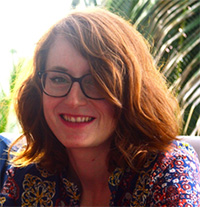 "It is really exciting to work at the frontier of a new research area." Johanna Wagner, Postdoctoral Scholar at the Institute for Neural Computation (INC) at UC San Diego, enthusiastically discusses her research. "When I began my Ph.D. studies at Graz University of Technology in Austria in 2011, the field of Mobile Brain/Body Imaging (MoBI) was in its infancy. A lot of neuroscience research was done in extremely controlled settings -- people sitting in front of a computer in a dark room pressing buttons in response to mostly very boring tasks," she says candidly. "Instead, MoBI allows us to study natural behavior and movements in the real world."
"It is really exciting to work at the frontier of a new research area." Johanna Wagner, Postdoctoral Scholar at the Institute for Neural Computation (INC) at UC San Diego, enthusiastically discusses her research. "When I began my Ph.D. studies at Graz University of Technology in Austria in 2011, the field of Mobile Brain/Body Imaging (MoBI) was in its infancy. A lot of neuroscience research was done in extremely controlled settings -- people sitting in front of a computer in a dark room pressing buttons in response to mostly very boring tasks," she says candidly. "Instead, MoBI allows us to study natural behavior and movements in the real world."
As someone who has been fascinated about the brain since she was young, Dr. Wagner decided to delve head-first into the burgeoning field.
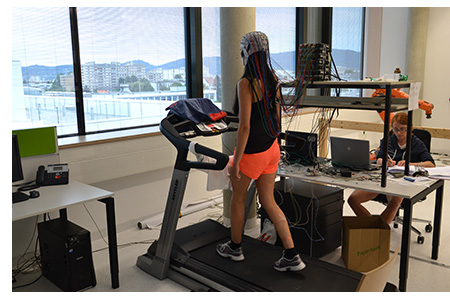 MoBI and Gait. One focus of Dr. Wagner's research involves running multimodal MoBI data collection paradigms including the electroencephalogram (EEG) recording to investigate cortical activity supporting gait. "I have been working on EEG brain dynamics of cortical inhibitory control and the role of these signatures in gait adaptation." (Photo: Dr. Wagner monitoring one of her EEG gait adaptation experiments.)
MoBI and Gait. One focus of Dr. Wagner's research involves running multimodal MoBI data collection paradigms including the electroencephalogram (EEG) recording to investigate cortical activity supporting gait. "I have been working on EEG brain dynamics of cortical inhibitory control and the role of these signatures in gait adaptation." (Photo: Dr. Wagner monitoring one of her EEG gait adaptation experiments.)
The recording of EEG during upright gait is extremely challenging because of movement artifacts in the EEG. When Dr. Wagner began her Ph.D., there were few EEG neuroimaging studies on gait. Fortunately, she admits, "I like challenging and difficult projects!"
She continues, "A crucial part of motor inhibition is performance monitoring – i.e., recognizing events, such as the sudden appearance of an approaching car or a barely visible patch of ice, that signal the need to inhibit or adjust motor actions and steps during walking." One of the EEG signatures of performance monitoring are error-related potential (error-ERP) features. "We showed, for example, that error processing in the brain, expressed as a scalp surface negative potential in the EEG, directly predicts gait adaptation performance on a single-trial basis and is directly involved in modifying single step responses during walking" (Wagner et al, 2019 Neuroimage).
 Dr. Wagner is proud of her team’s eye-opening research: "It has been suggested for a long time that gait movement is automatic and not controlled by the cortex. However, we showed that steady-state walking and step adaptation indeed requires cortical control." She continues, ”Using innovative analysis methods, we published one of the first studies showing neural oscillations supporting upright gait in humans (Wagner et al, 2012, NeuroImage), a finding that has recently been supported by others using recordings from local field potentials in the basal ganglia of Parkinson’s patients."
Dr. Wagner is proud of her team’s eye-opening research: "It has been suggested for a long time that gait movement is automatic and not controlled by the cortex. However, we showed that steady-state walking and step adaptation indeed requires cortical control." She continues, ”Using innovative analysis methods, we published one of the first studies showing neural oscillations supporting upright gait in humans (Wagner et al, 2012, NeuroImage), a finding that has recently been supported by others using recordings from local field potentials in the basal ganglia of Parkinson’s patients."
What might these results mean for people suffering from neurologic disorders? Dr. Wagner is excited to find out. "I want to determine what happens in the brain when movement that we take for granted is disrupted in neurological disorders such as Parkinson’s Disease, and what we can do to restore regular gait in these people ... Our findings suggest the possibility of investigating age- and disease-associated impairments of these control processes in gait disorders with a goal of developing biomarkers for use in fall risk prediction in conditions including early-stage Parkinson’s."
Background. Born in Munich, Germany, Dr. Wagner was raised close to Munich at Ammersee Lake, where she loved to swim. From an early age, she recalls being fascinated by how the mind works. "I was always interested in how people can have such different subjective experiences of the world – for example, how two people can experience and remember the same situation in completely different ways."
Determined to study the brain, she received her Master’s degree at the University of Technology in Berlin, Germany, while performing research in the Laboratory for Passive Brain Computer Interfaces (BCI) led by Dr. Thorsten Zander. She then earned her Ph.D. in Computer Science at Graz University of Technology in Austria and worked in the Institute for Neural Engineering under supervision of Professor Christa Neuper.
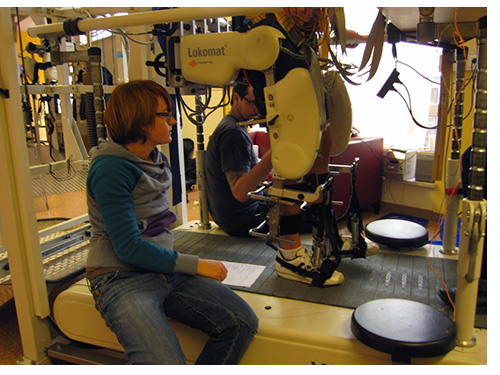 Swartz Center for Computational Neuroscience (SCCN). The SCCN, a Center of the UCSD Institute for Neural Computation, has been a big part of her research journey, interwoven throughout her education. "Dr. Scott Makeig co-pioneered the MoBI concept and approach, and the first study on EEG neuroimaging during gait came from the SCCN. (Gwin et al., 2011)" she shares. “It was only natural for me to come to the birthplace of MoBI to work with Dr. Makeig on the EEG data!” (Photo at left: Dr. Wagner preparing a participant for EEG recording while walking with an exoskeleton gait orthosis)
Swartz Center for Computational Neuroscience (SCCN). The SCCN, a Center of the UCSD Institute for Neural Computation, has been a big part of her research journey, interwoven throughout her education. "Dr. Scott Makeig co-pioneered the MoBI concept and approach, and the first study on EEG neuroimaging during gait came from the SCCN. (Gwin et al., 2011)" she shares. “It was only natural for me to come to the birthplace of MoBI to work with Dr. Makeig on the EEG data!” (Photo at left: Dr. Wagner preparing a participant for EEG recording while walking with an exoskeleton gait orthosis)
During her Master's degree program, Dr. Wagner had gained some experience working on EEG and source analysis using ICA in EEGLAB, and had read some of Dr. Makeig’s papers. Her first visit to SCCN occurred in 2010, during her Master's, with Thorsten’s group.
"Working with Dr. Makeig - his visionary approach to EEG imaging - gave me a glimpse of what is possible with EEG data analysis and motivated me to start a Ph.D. in Computer Science with a focus on Neuroscience and EEG.” Then, during her Ph.D. period, she presented a poster at the first International MoBI conference in Delmenhorst, Germany. Fortuitously, Dr. Scott Makeig also attended.
"Dr. Makeig was interested in my poster and my experiment, and he invited me to come to San Diego to work on the data analysis with him. I applied for a Marietta Blau Scholarship for Excellent Ph.D. Students by the Austrian Ministry of Science, and in November, 2014 came to SCCN for six months. The visit resulted in a very nice paper in the Journal of Neuroscience and my wish to return to San Diego and the SCCN.” After completing her Ph.D. in 2015, she returned to UC San Diego in June 2016 to start a Postdoctoral position in the department of psychology, switching after a year to the SCCN to work with Dr. Makeig. She has been a Postdoctoral Fellow there since.
Music and Transcranial Magnetic Stimulation (TMS). When speaking with Dr. Wagner, one is struck by her unquenchable curiosity, her drive to learn, and the diversity of her research. In addition to her interest in MoBI, EEG, and brain-computer interfaces (BCI), she is also passionate about investigating the effect music has on natural movements. "Music is used in some movement therapies for stroke and Parkinson’s patients and is thought to have a beneficial enhancing effect on movement,“ she explains. “The neural mechanisms are, however, not clear. I am therefore interested in the brain mechanisms supporting music enhanced movement."
Another topic of interest is the use of transcranial magnetic stimulation treatment (TMS, or non-invasive brain stimulation) in treating neurological and psychiatric disorders. "It has been suggested that intrinsic brain activity can be modulated by TMS," she states. "I am very interested in studying what actually happens in the brain relative to these non-invasive brain stimulation techniques, and to use this information for TMS therapies." (Wagner et al, 2019, Frontiers in Human Neuroscience). She has started working on spectral EEG signatures of repetitive TMS to identify plasticity inducing mechanisms in the brain using the Independent Modulator Analysis Toolbox (IMAT) (see below).
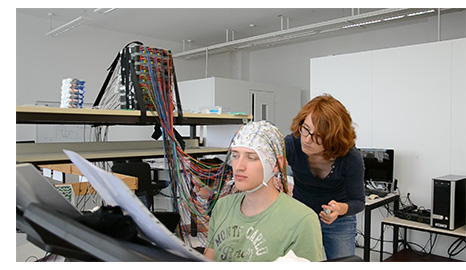 EEGLAB. Dr. Wagner enjoys the technical part of science and EEG analysis: "I love to dig into the EEG data and follow a more data driven approach in my analysis." (Photo to right: Dr. Wagner prepares a participant for an EEG gait recording).
EEGLAB. Dr. Wagner enjoys the technical part of science and EEG analysis: "I love to dig into the EEG data and follow a more data driven approach in my analysis." (Photo to right: Dr. Wagner prepares a participant for an EEG gait recording).
She first started working with EEGLAB during her Master’s studies. "I was working on error-related potentials (evoked potentials in the EEG that occur relative to an action error or to negative feedback following an erroneous response). During my first visit to the SCCN, I shared an office with Dr. Klaus Gramann, now Professor at the Technical University Berlin with a first MoBI Lab in Germany. Dr. Gramann showed me how to use many of the basics in EEGLAB that proved to be essential later in my Ph.D. – for example, the EEGLAB STUDY 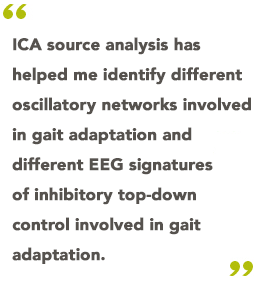 group analysis. During my Ph.D., I also took programming classes on biosignal processing and machine learning in Matlab.” As she gained more proficiency in the methods and programming, she soon began writing her own functions and scripts in Matlab, combining them with EEGLAB command line functions.
group analysis. During my Ph.D., I also took programming classes on biosignal processing and machine learning in Matlab.” As she gained more proficiency in the methods and programming, she soon began writing her own functions and scripts in Matlab, combining them with EEGLAB command line functions.
"EEGLAB is a great tool for visualizing data. I use EEGLAB in all my EEG preprocessing pipeline from filtering to data cleaning to running independent component analysis (ICA) to group analysis. I do all my analysis at the source level – directly on independent component processes. EEGLAB is essential for my research since in MoBI data analysis there is the additional problem of movement artifacts in the EEG. Source analysis with ICA is an invaluable tool to separate brain from non-brain artifact sources. ICA source analysis has helped me identify different oscillatory networks involved in gait adaptation and different EEG signatures of inhibitory top-down control involved in gait adaptation."
IMAT Toolbox. Dr. Wagner mainly uses Matlab with EEGLAB to write her own functions and scripts, as well as several toolboxes and plug-ins from the EEGLAB environment. She recently completed work on a new plug-in toolbox, the Independent Modulator Analysis Toolbox (IMAT). It can be used to estimate common spectral independent modulation patterns in the activities of EEG sources. The method decomposes log-spectral fluctuations of multiple ICs into a sum of distinct spectral modulator processes.
Dr. Wagner explains, "Independent modulator (IM) processes might reflect coordinated actions of modulatory factors, for example thalamocortical feedback loops and/or brainstem based neuromodulatory systems. Oscillatory processes in the EEG occur at different frequencies and these frequencies are often volatile on short time scales, depend on cognitive state, and differ between cortical source areas. IMAT allows identifying common spectral profiles across (maximally) independent brain source processes. IMAT also allows separating overlapping spectral characteristics for individual brain sources - for example, high and low alpha rhythm modes with their harmonics versus pure beta band activity. This method is especially interesting for investigating oscillations induced in the brain by TMS. Julie Onton originally developed this IM method with Dr. Makeig; to create the toolbox I have worked from her scripts with her help." (Click here for more details about IMAT).
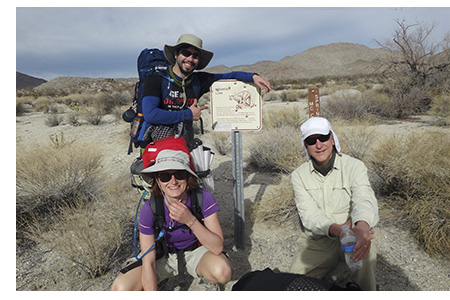 Collaboration, friendship, and more. By following her lifelong interest in the brain, Dr. Wagner not only found her professional calling. She also met her lifelong partner.
Collaboration, friendship, and more. By following her lifelong interest in the brain, Dr. Wagner not only found her professional calling. She also met her lifelong partner.
"I met Ramon Martinez-Cancino when I came to the SCCN in 2014 during my Ph.D. years" She recalls with a smile, "When I arrived, Ramon was in France for three weeks, and they put me at his desk. When he came back and saw me sitting at his desk his first thought was that he had been fired."
But things quickly improved. "The first weeks, I shared an office with him and we became friends and went on many hikes together. (Picture: Dr. Wagner with Ramon and Dr. Makeig on a three-day backpacking trip in the Anza Borrego Desert). With their shared research interests and love of nature, a romance soon blossomed. “The rest is history!“ she laughs.
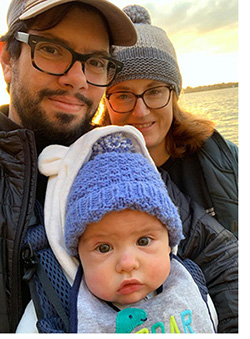 The two were married in November 2016 and had a son named Teo in 2020. (Photo at left: Dr. Wagner with her husband and son).
The two were married in November 2016 and had a son named Teo in 2020. (Photo at left: Dr. Wagner with her husband and son).
What is it like to be married to a work colleague? “We usually work on separate projects,“ she shares, “but we are both passionate about our work and often discuss our research with each other.“ Ramon, for instance, has contributed to Johanna's recent MoBI paper on trial-by-trial EEG analysis during gait adaptation (Wagner et al., 2019, NeuroImage), as well as the IMAT toolbox. After receiving his own Ph.D. in Electrical and Computer Engineering, he has recently moved from UC San Diego to work for Brain Products, an EEG research systems company.
The Future. Dr. Wagner is excited about the future. "A next important step in my career is to translate my findings of EEG imaging of gait to clinical applications." She hopes to identify oscillatory cortical networks and brain processing pathways impaired in neurological gait disorders which can be targeted with repetitive TMS. "I am interested in EEG biomarkers for gait disorders and developing new therapies using repetitive TMS and/or music."
As she speaks about her future, her voice fills with energy, "I would like to build my own lab and bring together people who study biomechanics of gait, people working on movement rehabilitation, both neuroscientists and engineers, to make the next step in MoBI research towards applications in clinical populations. To move forward in MoBI research, we really need to think about how and which movement parameters we want to use to examine the EEG relative to. To this goal, we need to think about new event-related paradigms for gait and MoBI research, and data driven methods for selecting and consolidating movement parameters."
While Dr. Wagner has a lot to contemplate in regards to her career, she also looks forward to a different type of gait project. Her eight-month-old son, Teo, has begun "crawling around and exploring everything!" It won’t be long until she watches him take his own first steps.
R. Weistrop, February 2021
_______________________
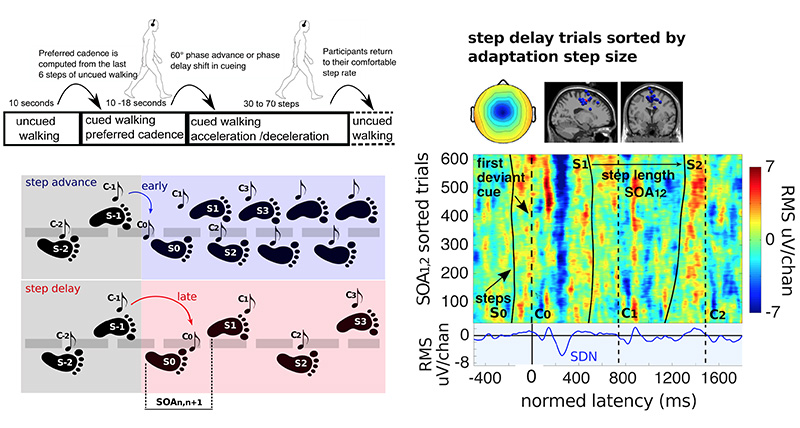
Figure above: Experimental paradigm and results of a gait adaptation experiment. Left: Gait adaptation was elicited using infrequent shifts in an auditory cueing sequence. Participants were required to step in time to the auditory tone sequence and adapt their step length and rate to unexpected occasional shifts in tempo of the pacing stimulus (i.e., following shifts to a faster or slower tempo). Right: Single-trial EEG responses stacked relative to the length of the step adaptation response (i.e., single-trial ERPs were sorted by the size of the ensuing adaptation step). A larger Step Delay Negativity (SDN) peak in the EEG trial predicted a larger ensuing adaptation step, in turn indexing the efficiency and speed of subsequent gait tempo adaptation. These results reveal trial-by-trial event-related coupling between simultaneously recorded, source-resolved EEG dynamics and gait adaptation behavior in humans (Wagner et al., 2019, NeuroImage; Wagner et al., 2019, Scientific Data).
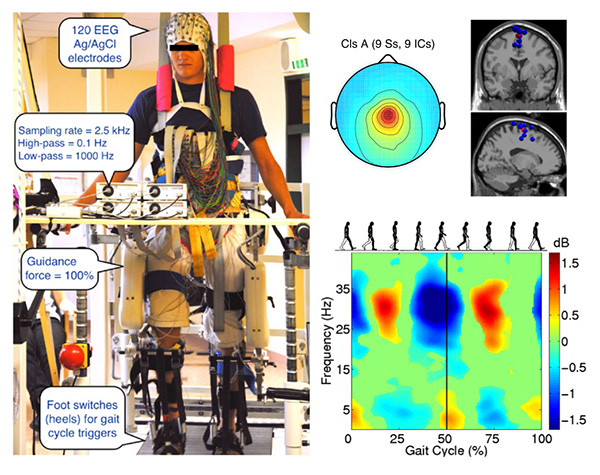
Figure above: Experimental setup showing a subject walking in a Lokomat gait orthosis. On the right is the source cluster mean scalp projection and brain equivalent dipole locations for an EEG source cluster in the Supplementary Motor Area (red ball, centroid), and (lower right) a cluster-mean Event Related Spectral Perturbation plot showing changes in spectral power during the gait cycle. The right leg heel contact (at 0%) marks the beginning and end of the gait cycle, the vertical line at 50% signs the temporally aligned event of left heel strike. (Wagner et al., 2012).
References:
Wagner, J., Martinez-Cancino, R., Delorme, A., Makeig, S., Solis-Escalante, T., Neuper, C., & Mueller-Putz, G. (2019). High-density EEG mobile brain/body imaging data recorded during a challenging auditory gait pacing task. Scientific Data, 6(1), 1-9.
Wagner, J., Martínez-Cancino, R., & Makeig, S. (2019). Trial-by-trial source-resolved EEG responses to gait task challenges predict subsequent step adaptation. Neuroimage, 199, 691-703.
Wagner, J., Makeig, S., Gola, M., Neuper, C., & Müller-Putz, G. (2016). Distinct β band oscillatory networks subserving motor and cognitive control during gait adaptation. Journal of Neuroscience, 36(7), 2212-2226.
Wagner, J., Makeig, S., Hoopes, D., & Gola, M. (2019). Can oscillatory alpha-gamma phase-amplitude coupling be used to understand and enhance TMS effects? Frontiers in human neuroscience, 13, 263.
Wagner, J., Solis-Escalante, T., Grieshofer, P., Neuper, C., Müller-Putz, G., & Scherer, R. (2012). Level of participation in robotic-assisted treadmill walking modulates midline sensorimotor EEG rhythms in able-bodied subjects. Neuroimage, 63(3), 1203-1211.
Wagner, J., Solis-Escalante, T., Scherer, R., Neuper, C., & Müller-Putz, G. (2014). It's how you get there: walking down a virtual alley activates premotor and parietal areas. Frontiers in human neuroscience, 8, 93.